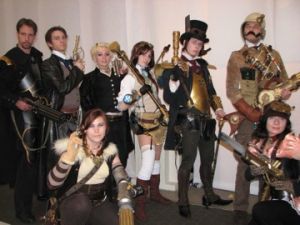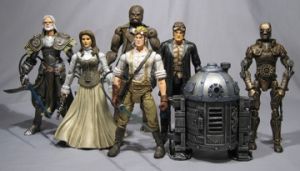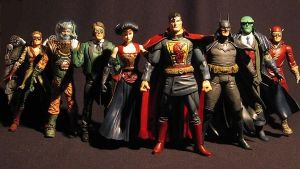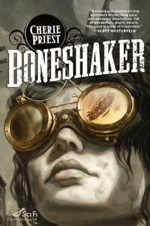Comics /
Cult Favorite
Steampunk 101
By Philip Schweier
October 26, 2010 - 12:02
 |
| Steampunk costumes |
I usually attend Dragon*Con in Atlanta, GA, in a comic book frame of mind, eager to meet the visiting pros, maybe get a few books signed and pick up additional back issues to plug holes in my collection.
Dragon*Con 2009 was a significant disappointment in that regard. Selection in the dealers’ room was weak, and most vendors were over-priced. But I did come away with a growing curiosity for a science fiction sub-genre known as “steampunk.” This year, comic books took a backseat as the growing curiosity has become a significant interest.
Sometimes referred to as “alternate history” or “gas lamp romance,” steampunk is a relatively new venue for storytelling, though in some ways it’s almost a precursor to what has been regarded as science fiction during the past 50 years.
The term “steampunk” was coined by science fiction author K. W. Jeter in a letter published in the April 1987 issue of the science fiction magazine
Locus. Jeter, referring to the Victorian fantasies replacing the “cyberpunk” movement, took the term from the notion that steam was the prevailing power source of the 19th century.
Like many sub-genres, steampunk comes with certain elements that help define it. However, one missing ingredient might be archetypes; characters who embody and are representative of a genre, such as Indiana Jones, Sam Spade or Gandalf.
 |
| Star Wars |
Nevertheless, there are certain patterns. Plot elements involving crazed inventors, airships and a polished-wood-and-brass design aesthetic are common. All of these harken back to the earliest science fiction authors such as Jules Verne and H.G. Wells.
Unlike traditional science fiction, which often takes place in technologically advanced settings, steampunk is often set in a pre-industrial society, usually the late 19th century. Heroes are often young, and most stories feature an eccentric inventor/scientist type who may be either an ally to the hero or the hero’s arch nemesis.
The common premise of steampunk writings often involve the “what if?” scenario: What if a specific technology was applied to the late 19th century? And by extension, it is possible to reverse the thought: What if pre-industrial technology was applied to the future? Some fans might suggest Joss Whedon’s
Firefly answers that question.
 |
| Justice League of America, a la steampunk |
In any event, the what if? scenario permits writers to twist time and space to suit their needs, often leading to stories of time travel and other more familiar aspects of science fiction. Technology is familiar from today’s perspective, if not entirely realistic.
Like any creative movement, the aesthetics of steampunk can be found in the visual arts as well, often resulting in the creation of steampunk-style devices and clockwork-style kinetic sculpture. Some of the more inventive afficianados have created fully-functional items, such as lamps, CD players and even home computers.
Many steampunk costumes feature a Victorian-era design, though sometimes comfort and practicality are sacrificed. In addition, steampunk has infiltrated the music scene as well, influencing such bands as Abney Park and the Extraordinary Contraptions.
On film,
Steamboy (2004), an Japanese animated feature, is perhaps the epitome of steampunk on film. Other examples include
Castle in the Sky (1986) and
Howl’s Moving Castle (2004), both from Japanese animator Hayao Miyazaki. Both films contain elements of magic as well as science, but in science fiction and fantasy stories, this is allowed.
Steampunk has yet to be portrayed suitably in a live-action film, though such mainstream Hollywood movies such as
Wild Wild West (1999) and
The League of Extraordinary Gentlemen (2003) might be the closest approximation. The ABC TV series
Castle recently featured a steampunk theme.
Some fans of steampunk might be quick to dismiss such films, perhaps due to their overall lack of box office success. In my opinion, success or failure is an inaccurate means of gauging the degree of steampunk elements.
Author Cherie Priest included zombies in her best-selling novel
Boneshaker, drawing criticism from some fans who might argue that “true” steampunk must be set in England during the Victorian Era (1838-1901). Given that steampunk is such a relatively young genre, it has yet to be clearly defined, which means the only limits are those of one’s own imagination. Priest’s follow-up novel in her Clockwork Century books, was released in late September. Entitled
Dreadnought, it is not a sequel, but clearly takes place in the same universe as
Boneshaker. While I have not read it, yet, I am eagerly looking forward to it.
Praise and adulation? Scorn and ridicule? E-mail me at philip@comicbookbin.com
Last Updated: March 3, 2025 - 20:40



